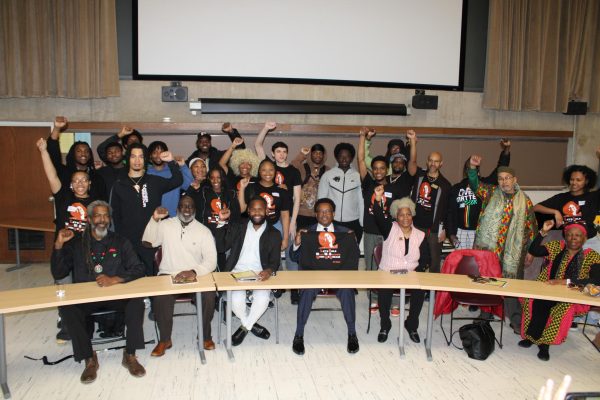Being vegetarian in weck and wing city proves to be easier than expected
As I walk through the dining hall line on campus, I fill my plate with salad, garden burgers, bean burger melts, or tofu and rice dishes, usually with a side of vegetable chili or tomato basil soup. When I go to the store, my grocery cart gets filled with veggie burgers, soy “chik’n,” and tofu corn dogs.
When I dine out, I order meals like eggplant Parmesan with spaghetti, vegetable and cheese pizza, or a grilled cheese penne.
Even at fast food joints like Subway, I can find a veggie sub, and at Burger King I can enjoy a veggie burger with fries and a strawberry milkshake. Yum.
And I do all of this easily, while avoiding meat.
I have been a vegetarian for seven years, and I am not alone.
According to Vegetarian Times magazine, roughly 7.3 million Americans are vegetarians. More than half of them are under 30. Another 1 million Americans are vegans, and another 22.8 million have vegetarian-inclined diets.
There are actually many different types of diets that fall under the vegetarian category — there are vegetarians who eat no meat, no eggs, and no fish, while other vegetarians eat no meat but eat eggs. Pescatarians eat no meat, but they eat eggs and fish. Vegans eat absolutely no meat or animal products- including eggs, milk, and cheese.
A vegetarian-inclined diet is one with meat and fish, but is a diet rich in many other foods and frequently does not include meat.
The main reason people eat less meat is to save animals; however, many are skeptical of whether or not vegetarians are really making a difference in sparing the deaths of animals. Well, they are.
Every person who cuts out meat from their diet directly decreases the number of animals who are slaughtered. According to the Web site CountingAnimals.com, the average vegetarian saves over 406 animals a year — including land animals, fish, and shellfish — meaning a vegetarian saves an animal’s life every day of the year. Of that number, 30 are land animals, including cows, pigs, chickens, turkeys, bison, goats, sheep, and ducks.
When many people picture the lives of the animals they eat, they picture that pig or cow or chicken running around free on a farm before their life is ended. However, in today’s world, this is hardly the case.
Factory farming is the reality of today’s meat slaughtering industry. Animals are held in tiny cages or pens, not being able to move around, going insane and becoming injured and often diseased, before their depending deaths take them out of their misery. We have laws against cruelty to animals such as dogs or cats, but farm animals still do not have the rights other animals are given.
Many people refute vegetarianism to save animals by saying that we eat meat in order to maintain the animal population. However, they never consider that most of the farm animals on this planet are bred simply to be eaten, not breeding on their own.
Besides saving animals, vegetarianism also saves the lives of people. According to the Vegetarian Resource Group, switching from an average American diet to a vegetarian diet can add 13 years onto your life. Eating less meat can also help to ward off disease, keep your weight down, and help you have more energy. Having a vegetarian diet can also reduce the risk of food-borne illnesses — for 76 million food illnesses a year result from food, most of those coming from eating meat or fish.
Being vegetarian can surprisingly help reduce pollution as well, for over 173,000 miles of polluted rivers and streams are caused by animal waste runoff by factory farms. According to National Agriculture, 70 percent of all grain produced in America is produced to feed farm animals bred and raised to be slaughtered. If that grain was instead fed to people, America could feed 800 million more people a year, helping to reduce famine.
Eating a vegetarian diet also helps to save money, for meat tends to be more expensive than vegetables, fruits, grains, and soy products. Vegetarian Times says if you substituted 400 pounds of vegetarian food for 400 pounds of meat and fish, you would save an average of $4,000 in just one year.
In this day and age, with the growing popularity of the vegetarian-based or inclined diet, it’s relatively easy to live on this regimen. You no longer have to go to special health food stores or organic food suppliers to get soy, tofu, and vegetable meat substitutes. Almost all grocery chains carry brands such as “MorningStar” and “Boca,” which are 100 percent vegetarian or vegan and are relatively cheap. Restaurants are starting to have bigger and more expanded vegetarian sections as well — even “Taco Bell” has an all-vegetarian menu.
Schools and businesses across the nation, too, are becoming more vegetarian-inclined. Places like these are even participating in the widely spreading “Meatless Mondays,” where just one day a week, employees and students abstain from eating meat.
Colleges, especially, are making sure that they are catering to students with a variety of diets, including vegetarian. Almost every day, Buffalo State has cheese quesadillas alongside the chicken ones, vegetarian chili along with the beef chili, and tofu with rice alongside chicken with rice meals.
It is relatively easy, and extremely healthy, to eat a little less meat in your diet. I’ve been doing it for seven years, and I plan on doing it for a lifetime. It’s a breeze most of the time — and I’ve never felt better.
Email: [email protected]









